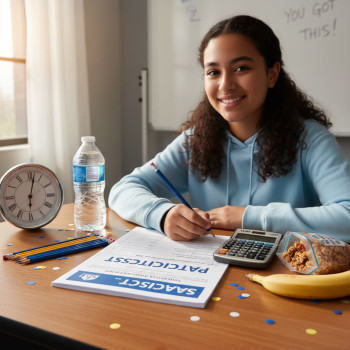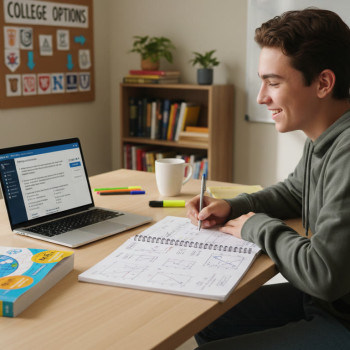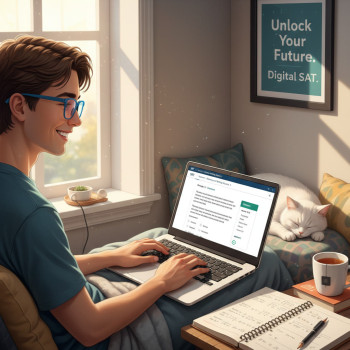Why your study space matters more than you think
When you’re gearing up for the Digital SAT, it’s tempting to believe that practice tests and content mastery are the whole story. They’re major parts of the picture, but so is the environment in which you prepare. Your brain responds to cues: clutter signals ‘unfinished business,’ a noisy room screams ‘pay attention to everything else,’ and a comfortable chair whispers ‘nap time.’ Creating a distraction-free study space isn’t about perfection—it’s about building an environment that consistently nudges your attention toward the task at hand. Think of the space as a training partner that either helps you focus or fights you for it.
What “distraction-free” really means
Distraction-free doesn’t have to be sterile. It means minimizing interruptions that sap time and mental energy, putting helpful tools within reach, and creating a predictable context that signals to your brain: this is focus time. For Digital SAT prep, that includes reliable internet and devices for Bluebook practice tests, a timer for timed sections, space for scratch work, and routines to enter and leave study mode. When you’re deliberate about these elements, you’ll notice smaller wins—longer stretches of attention, cleaner practice scores, and more calm on test day.
Designing the ideal study corner: practical steps
Designing a functional study space starts with small, actionable moves. You don’t need a dedicated room—many top performers study in a corner of their bedroom or a quiet kitchen table. The key is intentionality. Below are practical steps that turn a corner into a high-performance study hub.
1. Choose the right spot
- Natural light: If possible, pick a place with natural light. Sunlight improves mood and alertness, which helps during long practice sessions. Avoid harsh glare on screens.
- Low-traffic area: Pick a spot that others in your home pass by less often—this reduces unexpected conversations and foot traffic.
- Proximity to resources: Keep your charging outlet, printer (if you use one), and reference books nearby so you don’t have to wander off mid-session.
- Noise level: If silence isn’t possible, plan for consistent background sound (soft instrumental playlists or white noise) rather than unpredictable noises.
2. Set up ergonomic and functional furniture
Your body and posture affect cognitive stamina. A supportive chair and a desk at the right height let you study longer without pain.
- Desk height: Your forearms should be roughly parallel to the desk surface when typing or writing.
- Comfortable chair: A chair with lumbar support keeps you from slumping—consider a cushion if needed.
- Screen placement: Position your laptop or monitor so the top of the screen is at or slightly below eye level to reduce neck strain.
- Writing space: Leave room for scratch paper and a calculator (the Digital SAT has a built-in calculator during Math sections, but physically writing can help thinking).
3. Declutter and organize
Clutter competes for attention. Spend 10 minutes before each study session to clear unrelated items. Keep only study essentials on the desk: device, notebook, pens, water, and a timer.
Tools and tech: what to keep and what to hide
For the Digital SAT, technology plays a dual role—it’s essential for official practice and testing but also a major source of distraction. The secret is to keep tech tools that help you study prominently and hide or restrict the ones that pull you away.
Essential tools
- Reliable computer or tablet: Use the device you’ll practice on so you’re familiar with the feel and layout.
- Bluebook practice access: Practice on the Bluebook app or the digital platform used for the Digital SAT to mimic conditions. Doing full-length adaptive practice here is the most accurate rehearsal you can get.
- Timer or focus app: Use a simple stopwatch or the Pomodoro technique (25–50 minutes work, 5–10 minutes break) to build sustained attention.
- Noise management: If family noise is unpredictable, noise-cancelling headphones or white-noise machines help maintain consistency.
Hide or limit distractions
- Phone stealth mode: Put your phone in another room, on airplane mode, or in a drawer. If you need it for the timer, place it face down and limit notifications.
- Browser blockers: Use a website blocker during study blocks to prevent sudden tab drifting into social feeds.
- Minimal tabs: Keep only the windows required for the study session open—Bluebook, practice notes, and a digital timer if needed.
Lighting, color, and ambiance: small changes that boost focus
Lighting and color subtly affect energy and concentration. These aren’t cosmetic choices: they influence circadian rhythm, mood, and the brain’s readiness to work.
Lighting tips
- Mix natural and task lighting: Soft overhead lighting plus a bright desk lamp reduces eye strain and keeps you alert in evening sessions.
- Adjust for screen glare: Position lights so they don’t reflect on your screen. A matte screen protector can help.
Colors and sensory cues
Soft blues, greens, or neutral tones are calming and help focus. Keep sensory distractions low—strong scents or loud décor can be attention thieves.
Routines, rituals, and psychological cues
Routine turns intentional actions into automatic ones. Over time, small rituals create a mental pathway that signals it’s time to focus. These cues reduce the energy you spend ‘deciding’ and increase the energy you spend ‘doing.’
Effective pre-study rituals
- Five-minute desk reset: Clear the surface, set up tools, and open your practice material—this physical prep primes your mind.
- Warm-up question: Start with 5–10 minutes of a question of the day or a quick math problem to engage working memory.
- Statement of intent: Say out loud or write one specific goal for the session (e.g., “Complete an adaptive practice Reading section and review missed questions”).
Built-in review and cooldown
End every study session with a brief review: what you learned, what you’ll revisit next, and one tiny reward (a snack, a short walk). This helps encode learning and makes it easier to return the next session.
Study schedule and time-blocking for Digital SAT content
Focus on deliberate practice rather than hours alone. Time-blocking—allocating chunks for focused work—keeps momentum. Below is a weekly sample that balances skill work, full practice tests, and review.
| Day | Session 1 (60–90 min) | Session 2 (45–60 min) | Evening (optional) |
|---|---|---|---|
| Monday | Math skills practice (targeted problem types) | Grammar & editing drills | Light review:错题 notebook (20 min) |
| Tuesday | Reading passage strategies (timed) | Vocabulary in context + annotations | Short walk to reset |
| Wednesday | Full practice Bluebook section (adaptive) | Review missed items (error analysis) | Flashcard review |
| Thursday | Targeted mixed math practice | Writing & language passage review | Mock timing drills |
| Friday | Full practice test (every 1–2 weeks) | Relaxed reflection: note trends | Social time to recharge |
| Saturday | Skill workshops: weak-area focus | Timed drills | Light practice or rest |
| Sunday | Review week’s errors and plan | Free reading and mental reset | Prepare materials for Monday |
This schedule is a template—adapt it to your school, extracurriculars, and energy peaks. If you study best in the morning, place tougher tasks then. If evening focus is your strength, use mornings for light review and evenings for deeper work.
Managing interruptions and life realities
Even the best-laid plans get interrupted. The trick is not to eliminate interruptions entirely (that’s unrealistic) but to plan for them so they don’t derail momentum.
Communication and boundaries
- Share your calendar: Let family or roommates know your study blocks to reduce unexpected visits.
- Use visual signals: A simple sign—”In a study block: please do not disturb”—works wonders.
- Plan buffer time: Add 10–15 minute buffers between blocks to handle quick interruptions or phone calls.
Re-entry strategy
If you’re pulled away mid-session, have a quick re-entry routine: restart a 5-minute warm-up question, re-read your stated goal, and re-open the exact document. This reduces the ramp-up time to regain deep focus.
Active learning and retention strategies in your study space
The physical space supports learning best when paired with active techniques that produce durable results. Passive reading is comfortable but inefficient. Combine the right environment with active methods to accelerate improvement.
Active techniques to use at your desk
- Interleaving: Mix problem types within a math block instead of doing 20 similar problems in a row. This mimics the unpredictable selection you’ll see on test day.
- Self-explanation: After solving, explain (out loud or in writing) why the correct answer works—this clarifies thinking and exposes gaps.
- Spaced review: Revisit topics at increasing intervals. Use your study space consistently so the environment itself becomes a retrieval cue.
- Error logs: Keep a “mistake notebook” at your desk. Record why you missed a question and how you’ll avoid it next time.
Simulating test day in your study space
One of the best uses of your study space is to practice under test-like conditions. Build simulations that mirror the Digital SAT so your familiarity reduces anxiety on the real day.
How to set up a realistic mock test
- Bluebook environment: Take full-length, timed adaptive practice tests in Bluebook to mimic the interface and tools.
- Strict timing: Use the official section times and enforce them. Don’t give yourself extra breaks unless you have an approved accommodation.
- Test-day kit: Keep your test-day setup ready—water, snacks, a clean workspace for scratch paper, and a fully charged device.
- Dress comfortably: Wear what you plan to wear on test day so there are no surprises.
The human side: motivation, accountability, and personalized help
Creating a distraction-free space is part structure and part psychology. Motivation ebbs and flows; accountability and expert guidance keep you moving forward. If you find it hard to maintain consistency, short-term accountability—sharing goals with a friend or a tutor—can be transformative.
When to seek personalized support
If you’re plateauing despite good study habits or you need a plan tailored to your unique strengths and weaknesses, personalized tutoring can help. Sparkl’s personalized tutoring offers 1-on-1 guidance, tailored study plans, expert tutors, and AI-driven insights that help identify weak spots and craft efficient practice sequences. Working with a tutor can also help you use your study space more effectively by designing targeted home routines and simulating test-day scenarios in ways that match your learning style.
Quick checklist: set up your distraction-free study session
- Choose a low-traffic corner with good light.
- Clear the desk—only essentials on the surface.
- Place device, charger, and Bluebook ready to go.
- Phone out of reach or in airplane mode.
- Timer set (Pomodoro or official section timing).
- Noise plan: headphones or white noise if needed.
- Five-minute warm-up question before you start.
- End with a 10-minute error review and note one goal for next time.
Example: A real-world morning routine for high-energy focus
Here’s a realistic routine to maximize a morning study block when you’re fresh and alert. Adapt the timings to your own schoolday and energy patterns.
- 6:45–7:00 AM — Wake up, hydrate, light stretch, and a moment of breath to clear the head.
- 7:00–7:30 AM — Breakfast and 10 minutes of reading (a non-fiction article or novel helps build reading stamina).
- 7:30–7:35 AM — Desk reset: clear clutter, open Bluebook, set a timer.
- 7:35–8:30 AM — Focused session: practice an adaptive Reading section or targeted math problems.
- 8:30–8:40 AM — Quick review: record mistakes, mark patterns, set one improvement goal.
This compact morning routine uses a distraction-free space to channel your freshest attention toward high-value practice.
Final thoughts: make your study space a loyal teammate
The difference between a study space that supports you and one that undermines you is rarely dramatic; it’s a series of small choices repeated consistently. Light, layout, routines, and a few tech boundaries compound into better practice, clearer thinking, and stronger test-day performance. Remember: the goal isn’t a perfect room—it’s a reliable context that encourages your best work.
If you ever feel stuck or unsure how to make your study space work for your unique learning style, consider reaching out for personalized guidance. A tutor can observe how you study, suggest specific adjustments, and give you a tailored plan that fits both your life and your goals. Sparkl’s personalized tutoring can be a helpful fit here—offering 1-on-1 coaching, tailored study plans, and AI-informed strategies that help you turn a corner of your home into a powerfully focused study environment.
Start small. Declutter for five minutes today. Move your phone to another room during your next study block. Try one full Bluebook section under timed conditions this week. Little by little, your study space will become less of an afterthought and more of a secret weapon in your Digital SAT journey. You’ve got the tools, the plan, and the space—now practice with purpose.
Parting exercise: a 10-minute study-space audit
Before your next session, spend 10 minutes on this audit and make two quick adjustments:
- List three visible distractions and remove them.
- Set one environment cue (a specific playlist, a desk lamp, or a sign) that signals study time.
Then, start one focused 25–50 minute block. See how much more smoothly you move through practice when your space is on your side.
Good luck—study intentionally, practice adaptively, and treat your study space like the teammate it can be. Your focus, progress, and confidence will thank you.
















No Comments
Leave a comment Cancel